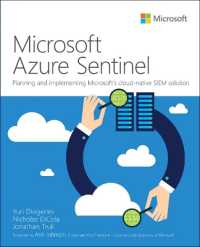- ホーム
- > 洋書
- > 英文書
- > Computer / Languages
Full Description
NOTEthe correct ISBN. Several versions of Pearson's MyLab & Mastering products exist for each title, and registrations are not transferable. To register for and use Pearson's MyLab & Mastering products, you may also need a Course ID, which your instructor will provide.Used books, rentals, and purchases made outside of PearsonIf purchasing or renting from companies other than Pearson, the access codes for Pearson's MyLab & Mastering products may not be included, may be incorrect, or may be previously redeemed. Check with the seller before completing your purchase. Java How to Program (Early Objects), Tenth Edition is intended for use in the Java programming course. It also serves as a useful reference and self-study tutorial to Java programming. The Deitels' groundbreaking How to Program series offers unparalleled breadth and depth of object-oriented programming concepts and intermediate-level topics for further study. Java How to Program (Early Objects), Tenth Edition, teaches programming by presenting the concepts in the context of full working programs and takes an early-objects approach MyProgrammingLab for Java How to Program (Early Objects) is a total learning package. MyProgrammingLab is an online homework, tutorial, and assessment program that truly engages students in learning. It helps students better prepare for class, quizzes, and exams-resulting in better performance in the course-and provides educators a dynamic set of tools for gauging individual and class progress. Teaching and Learning Experience This program presents a better teaching and learning experience-for you and your students. Personalize Learning with MyProgrammingLab: Through the power of practice and immediate personalized feedback, MyProgrammingLab helps students fully grasp the logic, semantics, and syntax of programming.Teach Programming with the Deitels' Signature Live Code Approach: Java language features are introduced with thousands of lines of code in hundreds of complete working programs.Introduce Objects Early: Presenting objects and classes early gets students "thinking about objects" immediately and mastering these concepts more thoroughly.Keep Your Course Current: This edition can be used with Java SE 7 or Java SE 8, and is up-to-date with the latest technologies and advancements.Facilitate Learning with Outstanding Applied Pedagogy: Making a Difference exercise sets, projects, and hundreds of valuable programming tips help students apply concepts. Support Instructors and Students: Student and instructor resources are available to expand on the topics presented in the text. Note: ISBN-10: 0133813436 / ISBN-13: 9780133813432 Java How to Program, Early Objects Plus MyProgrammingLab with Pearson eText -- Access Card Package, 10/e. This package consists of:ISBN-10: 0133807800 / ISBN-13: 9780133807806 Java How to Program, Early Objects, 10/eISBN-10: 0133811905 / ISBN-13: 9780133811902 MyProgrammingLab with Pearson eText -- Access Card -- for Java How to Program, Early ObjectsMyProgrammingLab is not a self-paced technology and should only be purchased when required by an instructor.
Contents
Print Book ChaptersChapter 1, Introduction to Computers, the Internet and JavaChapter 2, Introduction to Java Applications; Input/Output and OperatorsChapter 3, Introduction to Classes, Objects, Methods and StringsChapter 4, Control Statements: Part 1; Assignment, ++ and - OperatorsChapter 5, Control Statements: Part 2; Logical OperatorsChapter 6, Methods: A Deeper LookChapter 7, Arrays and ArrayListsChapter 8, Classes and Objects: A Deeper LookChapter 9, Object-Oriented Programming: InheritanceChapter 10, Object-Oriented Programming: Polymorphism and InterfacesChapter 11, Exception Handling: A Deeper LookChapter 12, GUI Components: Part 1Chapter 13, Graphics and Java 2DChapter 14, Strings, Characters and Regular ExpressionsChapter 15, Files, Streams and Object SerializationChapter 16, Generic CollectionsChapter 17, Java SE 8 Lambdas and StreamsChapter 18, RecursionChapter 19, Searching, Sorting and Big OChapter 20, Generic Classes and MethodsChapter 21, Custom Generic Data StructuresChapter 22, GUI Components: Part 2Chapter 23, ConcurrencyChapter 24, Accessing Databases with JDBCChapter 25, JavaFX GUI: Part 1Online ChaptersChapter 26, JavaFX GUI: Part 2 (PSR-Per Software Release)Chapter 27, JavaFX Graphics and Multimedia (PSR-Per Software Release)Chapter 28, NetworkingChapter 29, Java Persistence Architecture (JPA)Chapter 30, JavaServer (TM) Faces Web Apps: Part 1Chapter 31, JavaServer (TM) Faces Web Apps: Part 2Chapter 32, REST-Based Web ServicesChapter 33, ATM Case Study, Part 1: Object-Oriented Design with the UMLChapter 34, ATM Case Study, Part 2: Implementing an Object-Oriented DesignPrint Book AppendicesAppendix A, Operator Precedence ChartAppendix B, ASCII Character SetAppendix C, Keywords and Reserved WordsAppendix D, Primitive TypesAppendix E, Using the DebuggerOnline AppendicesAppendix F, Using the Java API DocumentationAppendix G, Creating Documentation with javadocAppendix H, UnicodeAppendix I, Formatted OutputAppendix J, Number SystemsAppendix K, Bit ManipulationAppendix L, Labeled break and continue StatementsAppendix M, UML 2: Additional Diagram TypesAppendix N, Design Patterns








